Henry Birdsall's Ancestors |
Click on a name for info, click on the back arrow to go back, click Home to go to the main page, or click for an Alphabetic List of all Names. |
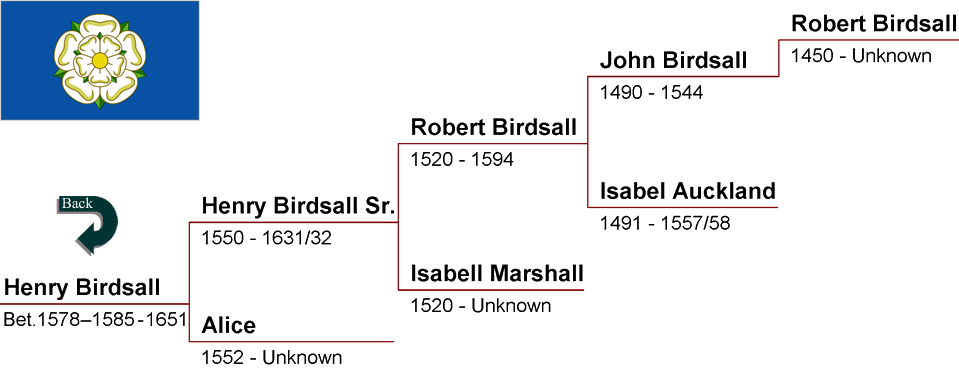 |
| Note: Before 1752 the year began on March 25th. Dates between January 1st and March 24th were at the end of the year, not the beginning. |
Henry Birdsall Sr. was born about 1550 in Doncaster, Tadcaster, or Kirkburton in Yorkshire, England (see below for info on these places) to Robert Birdsall and Isabell Marshall. He married Alice of Doncaster about 1570 and they had at least four children. According to the book, The Family Birdsall by Elizabeth Harris, there was a Birdsall named Thomas who lived in the Norwich area. This could be Henry Sr’s younger brother Thomas: “Thomas Birdsall and Alice Spendler were married 7 Jan 1588 at St. John Timberhill. They had children baptized at St. John Timberhill and St. Gregory´s between 1598 and 1602.” St. John Timerhill is the same church where Henry Jr’s daughter Anne was baptized in 1616. Harris continues with an explanation as to why Henry Jr. isn’t mentioned in his father’s will: “. . . Henry . . . made a will in 1625 in England and died in 1631, leaving things to children William, Thomas, and Mary, with no mention of Henry. However, . . . the oldest son, named for his father, received his share when leaving for the new world in about 1628.” George A. Birdsall, while writing his book, The Birdsall Family, asked Achievements Ltd, a genealogy company in Canterbury, to research Henry’s will. They responded with a list of Birdsall wills and among them was a Henry, described as a yeoman of Doncaster, dated 1-12-1631, the first day of the twelfth month, which at that time was February. Most researchers agree that Henry Birdsall Sr. wrote his will in 1625 and died in 1631-2 in Doncaster. |
| ~<^>~ |
Alice’s last name is unknown. The Birdsall Family book by George A. Birdsall says she was of Doncaster, Yorkshire County, England born between 1552 and 1554 to unknown parents. Some researchers call her Alice De Doncaster. She married Henry Birdsall about 1570 and had at least four children all born in Birdsall, in Yorkshire County – ancestor Henry; William about 1590; Thomas about 1600; and Mary about 1604. The book also tells us Alice Birdsall made her will in 1631, probably right after her husband’s death. It is not known when and where she died. |
| ~< Back to Chart >~ |
Robert Birdsall was born about 1520 in Kirkurton, Yorkshire, England, to parents John Birdsall and Isabel Auckland. Robert married Isabell Marshall about 1545 in Kirkurton. Isabel was born about 1520-22 in either Kirkurton or Tadcaster, Yorkshire, England, to unknown parents. They had at least three children – ancestor Henry; Thomas about 1555; and John about 1565. Robert Birdsall died on April 30, 1594; it is not known when Isabel died. It is believed that they both died and are buried in Birdsall, Yorkshire, England. Unfortunately there isn’t documentation to confirm these dates. Most of this information comes from George A. Birdsall’s book, The Birdsall Family: Genealogy and History, of Interest to Every Living Descendant and Their Posterity. |
| ~<^>~ |
John Birdsall was born about 1490 in England to possible parents Robert and Margaret Birdsall. These parents are uncertain as his older brother Robert married a Margaret, and it appears that some researchers may have confused his brother for his father. Without documentation his parents remain uncertain. John married Isabel Auckland about 1515 in England. Isabel was born about 1491-92 in Tadcaster, England to unknown parents. It is believed that John & Isabel had five children – ancestor Robert; William born about 1521; John in about 1522; Sibell about 1523; and Anne in about 1524. In George A. Birdsall’s book, The Birdsall Family, John is said to be “great grandfather of Henry who went to America.” Both John and Isabel are believed to have died in Tadcaster. There is a record in the Yorkshire Will Registry for a John Birdsall of Tadcaster who wrote his will on September 29, 1538, which was probated on April 30, 1544. It is probably our John Birdsall. Isabel is said to have died in 1557-8. |
| ~<^>~ |
Robert and Margaret Birdsall may or may not be the names of the parents of ancestor John. What is known is that John’s father was born about 1450 to unknown parents in England. His mother was born in Tadcaster in York County. They married in Tadcaster and had at least three sons there – Robert born about 1485, who died in France in 1514 fighting under Henry Percy, the 5th Earl of Northumberland against King Louis XII; ancestor John; and the youngest son Christofer, birth date unknown, who is believed to be the father of the Canadian Birdsalls. Where and when the Birdsall parents died is unknown, but some researchers say it was in Doncaster, Yorkshire, England. In the present church of St. Mary's in Birdsall there is the Tomb of Lady de Briddesale, which has a plaque above which reads “The recumbent figure is clothed in 14th century costume and surrounded by kneeling figures. Above her head is a symbolic representation of the soul ascending, supported by two angels. The family lived at Birdsall in the 13th and 14th centuries. Robert de Birddesale held one knight's fee in Birdsall of William de Paganel. Gilbert de Birddesale held two carucates of the fee of Peter de Mauley. The tomb, which has been much damaged, possibly at the time of the Reformation, was removed from the old church to its present site in 1824.” These folks may very well be ancestors. |
| ~< Back to Chart >~ |
Yorkshire |
Yorkshire was so named as it is the Shire (administrative area or county) of the City of York or York's Shire. A.D.Mills in the Oxford Dictionary of British Place Names tells us that York comes from the Viking name for the city, Jórvík. Shire is from Old English, scir, and appears to be allied to shear as it is a division of the land. Yorkshire was first divided into Thrydings (of Viking origin), meaning Thirds, which were the three historical ridings of Yorkshire (mouse over map)called East Riding (3), West Riding (2) and North Riding (1) and then into wapentakes. The East and North Ridings of Yorkshire were separated by the River Derwent and the West and North Ridings were separated by the Ouse and the Ure/Nidd watershed. In 1974 the three ridings of Yorkshire were abolished and York which had been independent of the three ridings, was incorporated into the new county called North Yorkshire. It later became part of York Unitary Authority. Most researchers say that the ancestral Birdsall family home was in Birdsall just a few miles south of Malton in East Riding. Malton is about 57 miles northeast of Doncaster; about 48 miles northeast of Tadcaster; and 64 miles northeast of Kirkburton. All three of these towns are near Leeds within 32 miles of each other. These towns are where the Birdsall family traveled to and from, marrying and raising their children. Birdsall, sometimes called Brideshall by some researchers, is a village and civil parish in theRyedale district of North Yorkshire; in the union of Malton; wapentake of Buckrose; in the East Riding of York; and is about 4.5 miles south southeast (asthe crow flies) from Malton. This parish comprises nearly 4,000 The ruins (mouse over photo left) of the ancient church of St. Mary stand adjacent to Birdsall House, the home of Baron Middleton. The present church was built in 1824 at the expense of Henry Willoughby, 6th Baron Middleton. According to the 2001 census Birdsall had a population of 180. Click the link to read more about the Birdsall surname.
Tadcaster, 24.8 miles (as the crow flies) southwest of Birdsall, was founded by the Romans, who named it Calcaria from the Latin word for lime, reflecting the importance of the area's limestone geology as a natural resource for quarrying, an industry which continues today and has contributed to many notable buildingsincluding York Minster. Calcaria was an important staging post on the road to Eboracum (York), which grew up at the river crossing. St Mary's Church (mouse over photo right) was first built around 1150, though a wooden structure did exist prior to this. Destroyed by the Scots in 1318 in one of many incursions subsequent to the Battle of Bannockburn, St Mary's was rebuilt between about 1380 and 1480 but constant problems with flooding led to the structure being taken down stone by stone and rebuilt between 1875 and 1877 with the foundations raised by 5 feet; only the tower was left untouched. Doncaster, 42 miles (as the crow flies) south, southwest of Birdsall, is in South Yorkshire and the principal settlement of the Metropolitan Borough of Doncaster. The town is about 20 miles from Sheffield and is popularly referred to as Donny. A market has been held at Tadcaster since 1270, when Henry de Percy obtained a royal charter from Henry III to hold 'a market and fair at his manor of Tadcaster', to be held each Tuesday. This ancient market place can be seen at the junction of Kirkgate and Bridge Street.Today Doncaster has an international airport, and in recent years its centre has undergone regeneration including the development of an Education City campus, currently the largest education investment of its kind in the UK.
By 1334 Doncaster was the wealthiest town in southern Yorkshire and the sixth most important town in Yorkshire as a whole, even boasting its own banker. By 1379 it was recovering from the Black Death and had a population of around 1,500 people. The town was incorporated in 1461, and its first Mayor and corporation were established. By 1547 its population exceeded 2,000. The town was incorporated in 1461, and its first Mayor and corporation were established. Kirkburton, 50.7 miles (as the crow flies) southwest of Birdsall, is a village, civil parish and local government ward in the metropolitan county of West Yorkshire. It is 5 miles southeast of Huddersfield, in the Metropolitan Borough of Kirklees. The township comprises the two villages of Kirkburton and Highburton together with The origins of the village date back to the Iron Age when a settlement was believed to have been built on the site of the present All Hallows Church. A Saxon Fort is also believed to have stood on that site. The village is recorded in the Domesday Book as Bertone in Wachefeld as being in waste. After the Norman Conquest the village grew from the waste recorded in 1086. The two parts of the village were named after the church was built, Kirkburton housed the church whilst Highburton was built on the hill. In the Middle Ages the township was part of the Manor of Wakefield and Kirkburton church was at the head of a 16,000 acres parish, that extended to the Holme Valley. Dedicated to All Hallows, the church (mouse over photo right) was built in 1190 and is a Grade I Listed Building. Most of the church is 13th century although parts have been rebuilt. The tower was added in the 15th century. Inside the church is a late medieval nave ceiling, large wooden pulpit, stone font and Elizabethan and Jacobean pews. A small window in the chancel may have opened from the cell of a hermit. A restored 10th century stone crucifix can be found inside, supporting the belief that another church or Christian settlement may have existed on this site. The church has recently undergone extensive restoration. The churchyard has also undergone landscaping and is a designated wildlife sanctuary. |
| ~< Back to Chart >~ |
Yorkshire History of the Times |
The Yorkshire rebellion occurred during the reign of Henry VII. Parliament wanted money to help defend Brittany, which was allied to England, in the war against France. Henry sent Percy, Earl of Northumberland, to collect taxes to help raise some money. However, many of the people in Northumberland and Yorkshire claimed to have already paid their part through local taxes, and were unwilling to give more money to defend a country of no geographical threat to them, as Yorkshire and Northumberland are in Northern England, whereas Brittany is closer to Cornwall and London. Rebellion broke out in April 1489. The Earl met the rebels, but a scuffle broke out and he was killed. The rebels then asked for pardon but were denied it by the king who sent a large army to the north, led by the Earl of Surrey. The rebel leader, John á Chambre was hanged for treason, so they found a new leader in Sir John Egremont (an illegitimate member of the Percy family). Unfortunately for the rebels, Egremont proved to be unreliable and fled to the Court of Margaret, Duchess of Burgundy who was in staunch opposition to Henry's rule. As a results, Henry was unable to get enough money to defend Brittany and he became aware of the lawless nature of the North of England. The War Against France 1512–14. A convenient justification for King Henry VIII to go to war came in 1511 in the form of a plea for help from Pope Julius II, who was beginning to feel threatened by France. England formed an alliance with the Pope, Ferdinand V of Spain, and Maximilian I, Holy Roman Emperor against Louis XII of France. The first campaign against France was not a success, partly due to the unreliability of the alliance with Ferdinand. Henry learned from the mistakes of the campaign, however and, in 1513, still with papal support, launched a joint attack on France, in which Robert Birdsall Jr. fought in and died. The Anglo-French treaty of 1514 secured a temporary peace between the two nations. Under this treaty, the French king, Louis XII would marry Henry’s young sister, Mary. In addition England was able to keep the captured city of Tournai and to secure an increase in the annual pension paid by France. Meanwhile, a turnover of rulers in Europe threatened to diminish England’s influence. Peace with France in 1514 had been a true achievement for the King. With Henry’s sister, Mary, married to the French King, Louis XII, an alliance was formed, but Louis was not in good health. Less than three months later, Louis died and was replaced by the young and ambitious Francis I. Queen Mary had allegedly secured a promise from Henry that if Louis died, she could marry whomever she pleased. On Louis' death, she secretly married Charles Brandon, first Duke of Suffolk, with Francis I's assistance, which prevented another marriage alliance. As the only princess Henry could use to secure marriage alliances, this was a bitter blow. Wolsey then proposed an alliance with Spain and the Holy Roman Empire against France. Dissolution of the Monasteries: Between 1536 and 1540, the Dissolution of the Monasteries by Henry VIII had a profound and permanent effect on the Yorkshire landscape. Thousands of acres of monastic property was divided and sold to form the estates of the gentry and the newly rich industrial entrepreneurs. This happened right across the county from Guisborough Priory in the north through to Rievaulx Abbey on the North York Moors, Jervaulx Abbey and Fountains Abbey in the dales and Roche Abbey in the south. In all, 120 religious institutions were closed in Yorkshire. The unpopularity of the Tudor royals resonated in the Pilgrimage of Grace and Rising of the North. During the reign of Queen Elizabeth Yorkshire saw a steady rise in population. New industries created employment and wealth, and improved farming methods and imports of corn stopped food shortages. The steady rise in population created pressure to enclose common land for agriculture and the farming communities turned increasingly to cottage industries to make a living. |
| ~< Back to Chart >~ |
The Birdsall Name |
The name Birdsall derives from the place name in the East Riding of Yorkshire, England. In the time of the Domesday Book the place was known as Briteshala which in anglo-saxon means Brid's sloping land and it was occupied by one Ulchil (originally Ulfketyl). At this time all land was in the King's gift (William the Conqueror). Birdsall was given by him to his half brother Robert, Count of Mortain, who leased it to the Fossard family. Nigel Fossard built there the wooden castle of Monferrant which was soon destroyed by the Earl of Albemarle; the timber therefrom being used in the construction of Meaux Abbey. The Fossards, who held over ninety manors sub-let Birdsall to the family who took their surname "de Bridshalle", later de Birdsall, from that place. When the Fossard male line became extinct, a Mauley (de Malo Lacu), who married the Fossard heiress- in- line took over the Fossard holdings and became feudal overlord of the Birdsalls. The Birdsalls however were great barons in their own right until their fortunes changed in the first half of the fourteenth century. Not long afterwards we see that their descendants are lawyers and wealthy merchants in the City of York and others are minor landowners within the County. This archive material sheds light on life in mediaeval Yorkshire and on proud, and more humble, bearers of the name Birdsall. |
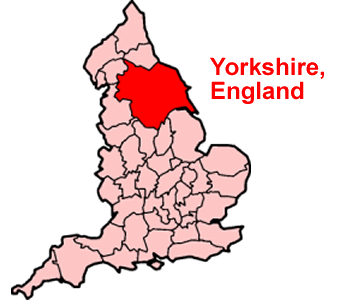 Yorkshire is a historic county of Northern England and the largest in the United Kingdom. Due to its great size in comparison to other English counties, functions have been increasingly undertaken over time by its subdivisions, which have also been subject to periodic reform. Throughout these changes, Yorkshire has continued to be recognized as a geographical territory and cultural region. The name is familiar and well understood across the United Kingdom and is in common use in the media and the military, and also features in the titles of current areas of civil administration, such as North Yorkshire, South Yorkshire, West Yorkshire and East Riding of Yorkshire. Within the borders of the historic county of Yorkshire are areas which are widely considered to be among the greenest in England, due to the vast stretches of unspoiled countryside in the Yorkshire Dales and North York Moors and to the open aspect of some of the major cities.Yorkshire has sometimes been nicknamed God's Own County.
Yorkshire is a historic county of Northern England and the largest in the United Kingdom. Due to its great size in comparison to other English counties, functions have been increasingly undertaken over time by its subdivisions, which have also been subject to periodic reform. Throughout these changes, Yorkshire has continued to be recognized as a geographical territory and cultural region. The name is familiar and well understood across the United Kingdom and is in common use in the media and the military, and also features in the titles of current areas of civil administration, such as North Yorkshire, South Yorkshire, West Yorkshire and East Riding of Yorkshire. Within the borders of the historic county of Yorkshire are areas which are widely considered to be among the greenest in England, due to the vast stretches of unspoiled countryside in the Yorkshire Dales and North York Moors and to the open aspect of some of the major cities.Yorkshire has sometimes been nicknamed God's Own County.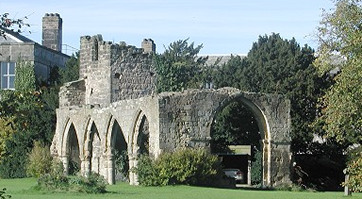 acres, and lies partly on the edge of the Wolds: the surface is mountainous, and the scenery wild and romantic; the soil is various, on the higher lands light and thin, and on the lower grounds a rich loam alternated with clay. Limestone and freestone of good quality are extensively quarried. The village is widely scattered, occupying a semicircular range of picturesque upward slopes at the western foot of the Wolds. (The Yorkshire Wolds are low hills that rise to an escarpment which then drops sharply to the Vale of York.)
acres, and lies partly on the edge of the Wolds: the surface is mountainous, and the scenery wild and romantic; the soil is various, on the higher lands light and thin, and on the lower grounds a rich loam alternated with clay. Limestone and freestone of good quality are extensively quarried. The village is widely scattered, occupying a semicircular range of picturesque upward slopes at the western foot of the Wolds. (The Yorkshire Wolds are low hills that rise to an escarpment which then drops sharply to the Vale of York.)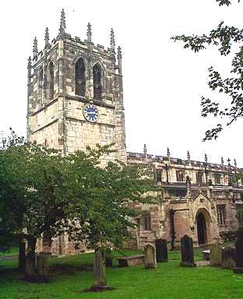 The town is mentioned in the 1086 Domesday Book as Tatecastre. The suffix of the Anglo-Saxon name Tadcaster is derived from the borrowed Latin word castra meaning fort, although the Angles and Saxons used it for any walled Roman settlement. Tadcaster is mentioned in the Anglo-Saxon Chronicle as the place were King Harold assembled his army and fleet prior to entry into York and subsequently on to the Battle of Stamford Bridge in 1066. Today it is a market town and civil parish in the Selby district of North Yorkshire. Lying near the Great North Road approximately 15 miles east of Leeds and 10 miles west of York. It is the last town on the River Wharfe before it joins the River Ouse about 10 miles downstream. It is part of the shire county of North Yorkshire, despite being further south than York, the traditional centre of Yorkshire and thus historically in the West Riding. A market has been held at Tadcaster since 1270, when Henry de Percy obtained a royal charter from Henry III to hold “a market and fair at his manor of Tadcaster, to be held each Tuesday.” This ancient market place can be seen at the junction of Kirkgate and Bridge Street.
The town is mentioned in the 1086 Domesday Book as Tatecastre. The suffix of the Anglo-Saxon name Tadcaster is derived from the borrowed Latin word castra meaning fort, although the Angles and Saxons used it for any walled Roman settlement. Tadcaster is mentioned in the Anglo-Saxon Chronicle as the place were King Harold assembled his army and fleet prior to entry into York and subsequently on to the Battle of Stamford Bridge in 1066. Today it is a market town and civil parish in the Selby district of North Yorkshire. Lying near the Great North Road approximately 15 miles east of Leeds and 10 miles west of York. It is the last town on the River Wharfe before it joins the River Ouse about 10 miles downstream. It is part of the shire county of North Yorkshire, despite being further south than York, the traditional centre of Yorkshire and thus historically in the West Riding. A market has been held at Tadcaster since 1270, when Henry de Percy obtained a royal charter from Henry III to hold “a market and fair at his manor of Tadcaster, to be held each Tuesday.” This ancient market place can be seen at the junction of Kirkgate and Bridge Street.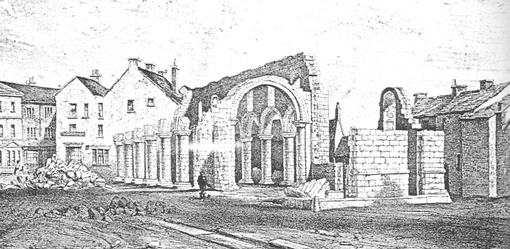 In 1248 a charter was granted for Doncaster Market to be held around the Church of St. Mary Magdalene, which in the 16th century became the town hall and was ultimately demolished in 1846 (mouse over image left). Some 750 years on, the market still exists with its busy stalls located both outside and under cover. During the 14th century a number of friars arrived in Doncaster who were known for their religious enthusiasm and preachings. In 1307 Franciscan friars (Greyfriars) arrived, and Carmelites (Whitefriars) arrived in the middle of the 14th century. In the Mediaeval period, other major features of the town included the Hospital of St. Nicholas and leper colony of the Hospital of St. James, a moot hall, grammar school, and the five-arched stone town bridge with a chapel dedicated to Our Lady of the Bridge. During this period, the township was protected by earthen ramparts and ditches leaving four substantial gates as entry points.
In 1248 a charter was granted for Doncaster Market to be held around the Church of St. Mary Magdalene, which in the 16th century became the town hall and was ultimately demolished in 1846 (mouse over image left). Some 750 years on, the market still exists with its busy stalls located both outside and under cover. During the 14th century a number of friars arrived in Doncaster who were known for their religious enthusiasm and preachings. In 1307 Franciscan friars (Greyfriars) arrived, and Carmelites (Whitefriars) arrived in the middle of the 14th century. In the Mediaeval period, other major features of the town included the Hospital of St. Nicholas and leper colony of the Hospital of St. James, a moot hall, grammar school, and the five-arched stone town bridge with a chapel dedicated to Our Lady of the Bridge. During this period, the township was protected by earthen ramparts and ditches leaving four substantial gates as entry points.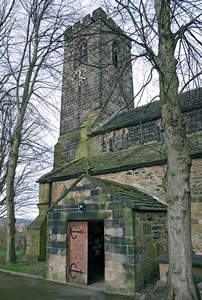 several hamlets, including Thunderbridge, Thorncliffe, Storthes Hall, Burton Royd, Riley, Dogley, Common Side, Causeway Foot, Lane Head and Linfit.
several hamlets, including Thunderbridge, Thorncliffe, Storthes Hall, Burton Royd, Riley, Dogley, Common Side, Causeway Foot, Lane Head and Linfit.